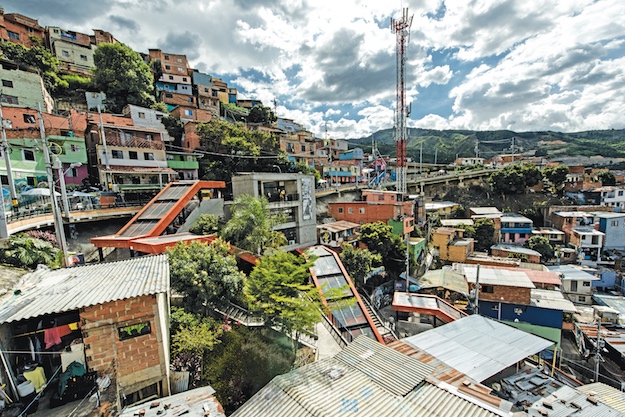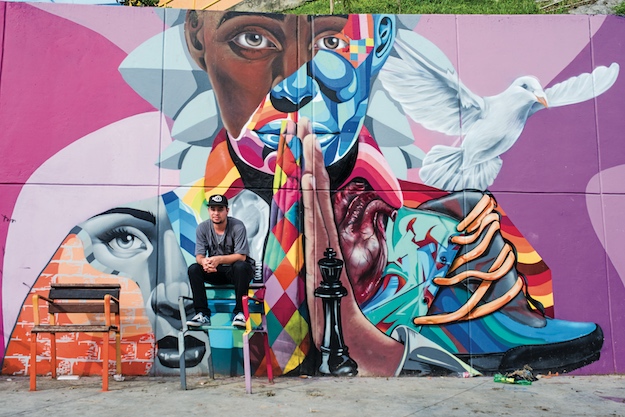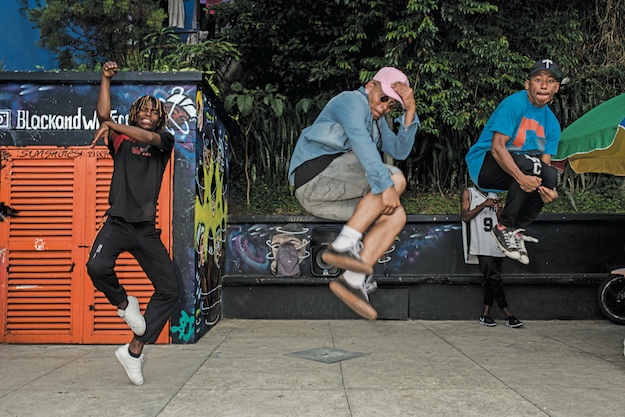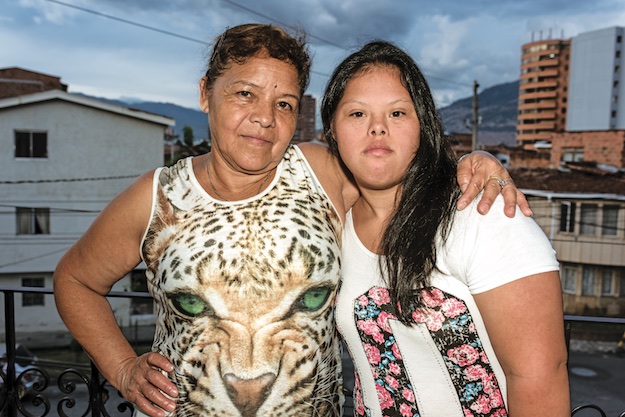This article is adapted from AQ’s print issue on reducing homicide in Latin America. | Leer en español
As she began to run afoul of a street gang in her working-class neighborhood in Medellín, Lina Carmona always kept a three-digit phone number in the back of her mind.
Carmona’s sin: Opening a nail salon in her home without asking the gang’s permission. After finding out, its leader demanded that she pony up a weekly “tax.” But it was the equivalent of a day’s income doing manicures, so Carmona refused. The gang leader then suggested payment-in-kind — meaning that she sleep with him.
“Of course I was scared,” Carmona told AQ. “But I tried not to show it.”
Angered by the pushback in a barrio where nearly every grocer, hardware store owner and hot dog vendor hands over extortion payments, gang members began yelling insults at Carmona and her husband on the street. They harassed the couple’s two children as they walked to school. They even kicked Kiara, the family’s Labrador retriever.
Tensions escalated until one evening, 10 gun-wielding thugs showed up at their door. Carmona’s husband pulled out his pistol, determined to go down fighting.
That’s when Carmona reached for her cell phone. She dialed 123, Colombia’s version of 911, and was connected to a new service that tries to help Medellín residents facing imminent murder — and in extreme cases whisks them away to safety.
Carmona coaxed her husband to a back area of the house, where they locked the door until the police arrived. Not all went smoothly: The agents showed up in a compact car the size of a Volkswagen Beetle, so deliverance from gang territory required several nerve-wracking trips. But within a few hours, the family was breathing easier in a safe house. The cops had even managed to save the dog.
A Window of Opportunity
Called the Homicide Prevention Protocol, the program has saved at least 58 people since it was launched last year. Andrés Llano, a government lawyer who helps evacuate at-risk citizens, told AQ, “If not for us, these people would be dead.”
It’s the latest initiative from a city that has for years been in the vanguard of violence-reduction efforts in Latin America — and offers proof that even the deadliest places are not hopeless. Since Pablo Escobar and his hitmen made Medellín the world’s murder capital in the early 1990s, with about 380 homicides per 100,000 people, that rate has plummeted by 95 percent. The City of Eternal Spring is safe enough these days that it has even become a niche destination for U.S. retirees.
In truth, though, even at today’s level of 20 per 100,000 people, homicides are still high — double the rate considered endemic by the World Health Organization, and six times higher than New York City. And it has been more or less stuck there since 2015. In neighborhoods like the one where Carmona lived, police rarely enter and gangs continue to be in charge — selling drugs and bootleg liquor, and doling out rough justice whenever it suits them.
Frustrated, Camila Uribe and her colleagues at Casa de las Estrategias, a Medellín research and human rights group, undertook a detailed study of a dozen recent gangland killings to see what they had in common. They found that in at least nine cases, the victims basically knew what was coming — because they owed debts or had otherwise angered the gangs. In one episode, Uribe recalls, a teenager was frantic to escape Medellín, but his mother lacked the handful of pesos required for bus fare. He died soon after.
“There is a window of opportunity to prevent these deaths,” Uribe said. “People are looking to escape, and we have to figure out how to help them.”
 Medellín’s Comuna 13
Medellín’s Comuna 13
Uribe and her colleagues took this mission to city hall, where Mayor Federico Gutiérrez has made further cutting the murder rate a top priority. The two sides came up with a pilot project that would locate people who were at risk, advise them on how to escape danger and, if necessary, move them to a safer place.
On a recent afternoon, about two dozen operators were sitting in the city’s emergency call center, fielding calls ranging from fires to runaway teenagers seeking advice. But when a caller expresses fear of being killed, they are put into the Homicide Prevention Protocol — and a separate network jumps into action. Psychologists provide assistance over the phone, and sometimes meet with them in their homes. Legal experts also offer advice. And special police evacuation squads are standing by in case it all goes horribly wrong.
Because the program mostly makes use of existing personnel and resources, it has a low cost — only about $42,000 per year. Since it was launched last July, it has fielded more than 100 calls. While there have been some close scrapes, everyone who called so far has made it out alive.
“They are very anguished about what’s happening to them,” said psychologist Ana Isabel Sánchez as she takes a break from answering calls on her headset. “They have lumps in their throats. Some cry for hours.”
The program has clear limitations — it’s not feasible, logistically or financially, to evacuate all potential homicide victims. Evacuees are left largely on their own to secure new homes, jobs or schools. Rather than attacking the source of the problem by dislodging the bad guys, the rescue operations amount to a purge of law-abiding citizens, implying de facto recognition of gang hegemony.
Steven Dudley, co-director of think tank Insight Crime, warned that removing young people from their communities may make them more vulnerable to gang recruitment themselves.
But others find the program innovative — especially at a time when the murder rate is rising across Latin America, and many in government and law enforcement have grown fatalistic. “I like its audacity,” said Eduardo Guerrero, a Mexico City consultant who advises state and local governments on security issues. Officials in Medellín, he added, “are not resigned to the inevitable.”
Also impressed was Robert Muggah, co-founder of Brazil’s crime-focused think tank Igarapé Institute. “We all look to Colombia as a source of experimentation.”
Getting Out
One recent SOS came from Yorman Vásquez. A skinny 22-year-old from a Medellín slum, Vásquez is a math whiz — which is how he first caught the attention of the gangs, known in Spanish as bandas. When he was 13, the banda that dominated his neighborhood hired him to keep the books on its sales of marijuana and cocaine and its income from shaking down merchants.
“I’m good with numbers so I did all of their accounting,” Vásquez said with a shy smile.
After three years as a junior varsity mobster he was caught by the police and scared straight. He finished high school, got a job in construction, started a family, and tried to keep his distance from the banda. That worked until January, when he received a call from a former colleague, nicknamed El Gordo, Spanish for “fatso.”
Fatso was in prison but continued to run gang business over the phone. Due to police roundups, he told Vásquez, the gang was shorthanded and needed him for temporary work selling drugs to prevent rival bandas from taking over the local market. Vásquez refused, explaining that he had a real job and was now the father of two toddlers and that his girlfriend was pregnant with their third child. A few days later he received a second call. Vásquez once again demurred.
Then came the third call.
“Fatso got really angry,” Vásquez recalled. “He told me that if I didn’t accept the job he would be sending me a bullet within two weeks.”
Vásquez and his family initially sought refuge at his father’s house. But it was only a few blocks away and he was soon spotted. Convinced the bandits were about to pounce, Vásquez dialed 123 and was connected to the Homicide Prevention Protocol. The police arrived within an hour.
“I had nowhere else to go,” said Vásquez, as he sits at the dining room table of the safe house where the police dropped him off. “I am so thankful.”
Over the last two decades, Medellín’s police officials have worked hard to prevent such confrontations from happening. They carried out pinprick raids in the most crime-ridden areas, helped negotiate ceasefires between gangs, and arrested gang leaders. More recently, a 2016 peace treaty that ended Colombia’s long-running war with the Revolutionary Armed Forces of Colombia (FARC) guerrilla group has helped to reduce levels of violence across the nation.
In addition to policing, officials have built libraries, parks and clinics in the slums, as well as a cable car system to connect their residents to the rest of the city. The goal of these public works is to encourage people to take pride in their communities and to start reclaiming them from the gangs.
The change can be shocking to long-time residents— and regular visitors. I first visited Comuna 13, which is made up of red-brick-and-tin-roofed shanties perched on a slope too steep for cars or buses, in 2002 when the bandas were on a rampage. During one interview a masked gang leader abruptly excused himself. Moments later gunshots rang out. Then, several hoodlums scurried off pushing a wheelbarrow. Inside was the body of a man they’d just executed.
Today in Comuna 13, American and European visitors ride up stylish outdoor escalators to take in graffiti artists, street poets and break dancers. They purchase paintings and souvenir T-shirts. They snap pictures and relax at juice bars with panoramic views of the city.
Pointing to a mural of an orange phoenix, tour guide and Comuna 13 native Daniel Marín declared, “Now, Medellín is rising.”
 Daniel Marín, a tour guide and Comuna 13 native
Daniel Marín, a tour guide and Comuna 13 native
But the city still has a long way to go. Using a black Magic Marker on a city map covering his office wall, Medellín crime expert Fernando Quijano drew lines through 70 percent of the city’s neighborhoods that he says are controlled by 350 bandas. Despite periodic police raids, he said the hoodlums operate with relative impunity because they bribe officers to look the other way. Not surprisingly, many victims of gang extortion and other crimes don’t bother reporting them.
Andrés Tobón, Medellín’s security secretary, told AQ that since Mayor Gutiérrez took office two and a half years ago, police have captured 100 gang leaders and 2,500 gang members in a drive to “eliminate their comfort zone.” He added that 400 of the 7,000 officers on the Medellín police force have been purged for corruption.
 A group of breakdancers from Comuna 13
A group of breakdancers from Comuna 13
But there have been some high-profile embarrassments. Last year Gustavo Villegas, Tobón’s predecessor as Medellín security secretary, was arrested for allegedly carrying out secret negotiations with mobsters. And in another shocking case, the bodyguard of a police general was caught moonlighting as an escort for a gang leader.
“That’s why these bandas are thriving,” Quijano said.
Worst-Case Scenario
Meanwhile, the gangs have become at once less violent and more efficient. These days killings, especially of police officers, are frowned upon by the underworld because they lead to more crackdowns. Gangs now prefer to co-opt rather than confront authorities. And in the end they can usually get what they want — like the ouster of uncooperative residents — without pulling the trigger.
“The gangs can simply use the threat of homicide,” said Juan Diego Restrepo, a veteran Medellín journalist who covers organized crime. “Even without killing, it is something very violent.”
As a result, the phones keep ringing at the emergency call center in Medellín.
Sánchez, the psychologist who answers calls, said the first priority is to calm down victims so they can think clearly about the best path forward. That often means moving in with friends or relatives or relocating to an area beyond the limit of the gang’s territorial control. But when callers appear to be in grave danger, the police move in to escort them out. The evacuees are then placed in temporary shelters and eventually sent to other parts of Colombia.
Extraction is the most extreme option. It means leaving behind nearly everything—houses, possessions, jobs and schools — to start anew. It’s a last-second desperation play, a Hail Mary to break out of the barrio.
The service is free and available to all. In fact, a few requests for salvation have come from gang members who have fallen out with their leaders. Nelson Ocampo, who directs the 12-member Homicide Prevention Protocol team, says their marching orders are to be neutral and not to judge people.
“Even if the person is a criminal, that is not an issue for us because nothing justifies murder,” he said.
A Medellín native, Ocampo has worked for years to help its troubled neighborhoods, including as a soccer coach who trained dozens of kids from gang-controlled slums. At 58, he remains an idealist.
“I feel blessed to have this opportunity,” Ocampo said. Even if the program saves just a few lives, he declared, “For me, it’s like a miracle.”
Like many of his colleagues, Ocampo also thrives on the adrenaline rush of the job. And some of their recent cases have been nail-biters.
One youngster called from a pay phone to say he was being chased by gang members, then abruptly hung up. That left operators in suspense for hours until he finally called back and arranged to be picked up. He was on a bus out of the city the next day.
Another dramatic case involved Sandra Borja and her 23-year-old daughter, Edith, who has Down syndrome. Confident that the police would not suspect her, gang members pressed Edith into serving as a courier, ferrying pistols and bags of cocaine in the pockets of a bulky trench coat.
“She obeyed but didn’t really know what she was doing,” Borja told AQ.
When Borja found out, she scolded the banda and grounded her daughter. Soon, four gang members were at her door insisting that Edith work for them. They told her, in effect, “Your daughter or your life.”
 Sandra Borja and her daughter, Edith
Sandra Borja and her daughter, Edith
Borja had few options. A 54-year-old house cleaner, she came to Medellín in 1998 to escape the guerrilla war that was raging in northern Colombia. She was forced to switch neighborhoods a few years later when a banda killed her 19-year-old son. She wound up in Comuna 13, where this time her daughter became the target.
With time running out — the gangsters had given Borja a week to hand over Edith — she dialed the 123 hotline. The two women were taken to a safe house where, along with about a dozen other recent evacuees, they are now contemplating their next move.
“They saved our lives,” Borja said. “But now we have to start from zero.”
Indeed, for many at the safe house the adrenaline rush of successful escape has given way to anxiety about the future. Dairo Rua, the husband of manicurist Lina Carmona, said he still fantasizes about going back to his old neighborhood with his pistol and exacting revenge on the ruffians who forced them out. He expressed frustration that city officials have, in effect, done a favor for the gangsters by removing some of the only people who resisted their rule.
“That sends a terrible message,” Rua said.
Back at the call center, psychologist Yohana Montoya, who worked closely with Rua and Carmona, understands their wrath. She’d like to do more, but the program is immediate and limited, like disaster aid. Survival is what really matters.
At the very least, she said, Rua and Carmona “can go on and do something new with their lives.”






